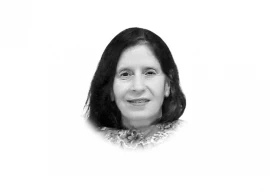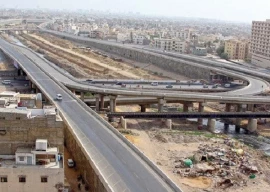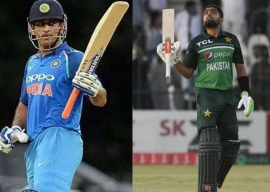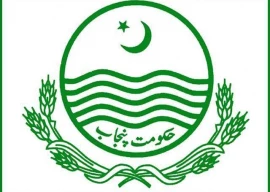
What is the position of the “chatty” crowd on the systematic murdering spree of the Hazara? Is the entire Hazara population an expert group of drone operators? Are the Hazara the frontline regiment of “imperialism” in “America’s War on Terror”? Is it possible, that the LeJ is just irritated at the empire and this violence is an expression of political dissent? Can they be pacified by an attentive ear, handshake and a hug? Should action be taken against them only when each and every child slow on uptake in the entire country agrees that something, perhaps, needs to be done? Utterly revolting and disgusting line of reasoning and questioning, is it not? In the alternate, there is a simpler and truer explanation. The LeJ is group of sectarian murderous brutes. And a simpler though not easy solution; that decisive force be used against them.
We are supposed to be careful in language; calling them “brutes” has not enough nuance of the conflict and might even hurt fragile, intellectual and apologetic sensibilities. You know, nobody should be “demonised”, etc. Not even people who kill three-year-old kids and attack vans full of girl medical students. Nope, they need to be “understood”. However, we do demonise people. We demonise the Hazara. Nelson Mandela is not dead yet. His spirit is certainly dead in Quetta. Some time ago, there was a news item about public transport operators refusing to allow Hazara passengers to board since that would make the vehicles targets, schools refusing admission, nobody willing to rent houses, etc. How does this not bother us, make us freeze? The most frequently targeted place in Quetta is called “Hazara” Town, and it is largely what the name suggests, a housing settlement full of Hazaras. “Apartheid” is not a term to be used lightly ever, yet the lesson taught by it runs the risk of becoming meaningless if it is not used for examples like these.
For everyone who has not been to Hazara Town and wants to engage in the “complex” debate over whether or not our state is complicit or, at least, looks the other way, let someone who has been there draw a sketch with markings of the FC check posts and the places of attacks. It is not much of a debate. However, it does not matter. Why tamper with a purely intellectual pursuit by bringing in trivial specifics like the distance of a few feet between FC check posts and targeted killing sites, again and again. How a thousand kilogrammes of explosives are stealthy enough to pass through these check posts, again and again. Let us keep it academic, shall we, US war on terror, drones, imperialism, corruption, national consensus, etc. Let us hope that there are still a few Hazaras alive to be grateful if and when we reach the carefully thought out consensus that something needs to be done to protect them.
Coming back to names, the “Jhangvi” in Lashkar-e-Jhangvi, perhaps, does not get enough attention. The parent organisation of the LeJ, the Sipah-e-Sahaba (SSP) (now ASWJ) was formed at Jhang, Punjab, in the 1980s. The LeJ faction split because the SSP was not “militant enough”. Which is saying something by the way, since the SSP did not exactly comprise tree-hugging pacifists either. The difference was on strategy, not on ideology. The ideology was, and is, that Shias should be eliminated. The long overdue operation has to simultaneously begin in Balochistan and Punjab, also dismantling the ideological hub. There is no consensus needed. Anyone who does not agree with the idea of an operation against the sectarian organisations murdering the Hazara is someone you don’t want to agree with in any event.
Much has been said about the proper use of the term “genocide” and if it is applicable to the Hazara killing. The question is an important but theoretical one with quibbles on international law definitions. Practically, it is instructive to read Samantha Power’s chillingly brilliant essay, “Bystanders to Genocide” on the Tutsi genocide in Rwanda. To quote Power, “A determination of genocide turns not on the numbers killed, which is always difficult to ascertain at a time of crisis, but on the perpetrators’ intent.” The perpetrators’ intent in the case of the Hazara can only be missed by someone who is trying really, really hard to miss it.
The mention of genocide reminds of the phrase, now hollowed by breach “Nie Wieder” (Never Again). It is important to recall it as we pass through another July 5th, the date when that psychopath Ziaul Haq illegally took over. One lesson from the Zia era has been that islands of intolerance and hate don’t work; they spill over, across national and provincial lines. During his reign, amongst innumerable heinous acts, one was the patronising of the sectarian terrorists by the state. Mian Nawaz Sharif was Zia’s prodigy. Once upon a time, long before the “War on Terror” and invention of drones, Mian Sahib was the chief minister of Punjab where these outfits were gaining initial strength. Mian Sahib knows their history all too well. Well enough to know that the Hazara killing is not only the Balochistan government’s problem. It is everyone’s problem. We are repeatedly told that Mian Sahib is his own man now. We want to believe that. Yet, he will still have to prove it. The time for consensus building and all parties’ conferences on dealing with sectarian terrorism is long gone. Either the security establishment is compelled to change its world view and the hobnobbing with these medievalists or there is a showdown. Thousands of Hazara lives are certainly worth having that confrontation. Our notion of State and Country, it seems, is now confined to the security establishment. So to our Guardians, Tujh ko kitnon ka lahu chahiye ae arz-e-watan, jo teray aariz-e-bayrung ko gulnaar karen, kitnee aahon say kalejaa tera thunda ho gaa, kitnay aansoo teray sehraaon ko gulzaar karen.
Published in The Express Tribune, July 7th, 2013.
Like Opinion & Editorial on Facebook, follow @ETOpEd on Twitter to receive all updates on all our daily pieces.
COMMENTS (27)
Comments are moderated and generally will be posted if they are on-topic and not abusive.
For more information, please see our Comments FAQ



















@Awais: It's Hazara killing not Shia killing, If it's Shia Killing than why only HAZARA are the soft targets, it's expected 20% of population of Pakistan is Shia, so why the HAZARA'S are targeted only here is few statistics from last three years In 2013 total Shia martyr in Pakistan is 300, only in Balochistan specially in Quetta more than 230 HAZARA has been martyr, It's Hazara Killing not Shia Killing In 2012 total shia martyr in Pakistan is 350 more than 130 HAZARA were in Balochistan and Quetta. In 2011 total Shia martyr in Pakistan is 250 more than 90 HAZARA were martyr in Balochistan and Quetta. It all show that it is HAZARA Killing not Shia Killing I am not making a story, It's report of different human right organization of national and international level, News paper is full of this kind of report, it all show that it's HAZARA killing not Shia Killing Punjab is largest province of Pakistan by it's population why any secetarian attack don't occur in Punjab, Apart from one or two incident of secetarian attack occur in Punjab It all indict that it is HAZARA killing not Shia Killing
Saroop, I never miss reading your enjoy your articles which cover very core issues and often touch very tender nerves. As usual what you have written about the Hazaras is thought provoking and accurate. Your articles could be so much better, nearly being brilliant, if you did not, in every article, show your very strong bias towards one political party or try and constantly glorify its founder. After all if you want to continue to write and enlighten people your writings must by totally unbiased. Is that not what journalism is all about?
Thanks for your insightful article, as highlighted in the article, LeJ and other outlawed organizations are in fact, losing momentum in Afghanistan fighting their holy war to seek place in heaven. But now, things has changed since the invasion of the USA. All it can be said that this is because of illiteracy, intolerance and narrow-mindedness of people.
@ashar: pls , NFP , is way above saroop , pls when making comparision keep some facts at hand go to Dawn and read few of his articles
Saroop Ejaz is NFP of ET.
Kindly focus on building your practice rather than wasting time googling authors and quotes to fit your pieces.
@author... Nothing is going to happen, this will keep on continuing until all the hazara's have been forced out. I would suggest that either the army act fast or the non wahabis in the land of the pure also start packing their bags..
With the recent surge in militant attacks all oer the country, you'd have to be a fool to think that our dear PM Nawaz Sharif isn't INTENTIONALLY ignoring these heinous acts.
It's almost as it he's made up his mind that he's going to focus on securing and developing Punjab only and take a blind sight to the rest of the country as it burns. As the article says, The LeJ, which is responsible for pretty much all the sectarian attacks on Shias in Quetta, KPK and Karachi, was born and continues to find a safe haven in Punjab, where the ruling party PML-N has likely struck a deal with them where they let them nurture under their sights so long as they keep their terrorist activities outside Punjab. And this isn't some crazy, baseless conspiracy theory that I've cooked up. Here's a conclusive article on the topic:
http://tribune.com.pk/story/512400/an-unholy-alliance/
It is true that there is a severe lapse on the part of provincial governments of Sindh, Balochistan and KPK as well as their law enforcement agencies, but really, even if they did sincerely try to root out the LeJ they wouldn't go very far with their top leadership operating safely out of Punjab.
I've said it before and I'll say it again ' when you're good you tend to be brilliant '.
When one sees the criminal activities of people like the LeJ or ASWJ etc the money and the idealogy seems to lead westwards to the land of oil, deserts and the mighty US dollar but the shameful blame of allowing this to happen and even more shamefully quietly condoning it ............rests with us and only us.
@Aysha M: wonderfully analysed current hate killing of shias , i totally agree individuals faith has no business to be determined by state . It was most heneous act by two psychopaths , the first one initiated it and the other took it to next level.
@shahid: thanks shahid for giving the reality, it is just we are ruled by one psychopath to another , well the now we have the spiritual son of great psychopath.to play havoc with our destiny
Thank you Saroop for constantly writing for the vulnerable, but unfortunately every now and then the pleas of oppressed fell on deaf ears (read, of security apparatus who have deep ties with the banned outfit). But we shall not stop protesting be it in form writing, rallying, vigil etc. until justice is done.
A sincere Hazara
This is not a coincidence but a well directed campaign against all those who are not extremist Sunni. As the population of minorities, smaller sect of Muslims, and liberals decreases the chances of Wahabi rule in Pakistan increases. The votes of smaller groups do not go to the rightwing parties and they could care less about their lives. Sharif are dictator Zia's political offspring and have a direct link with the extreme forces. It is note worthy that Zia came into power the night of July 4th and around the similar time the Egyptian army took over. The US public is busy in celebrations so they are away from the news and would condemn less. Retreating from Kargil also took place around this date!
@Haris Chaudhry: Very well said ! When people are unable to differentiate between right and wrong, the end could be near. Your call for introspection and opening up to the outside world will help in knowing the direction in which the nations ship is sailing. We live in the communications age which gives us access to all kinds of divergent opinions, in turn helping us to form our own opinions and draw conclusions.
The way Pakistan has created problems for itself and used violence to try and solve them could make a great case study for students of Psychiatry. When megalomania mixes with schizophrenia the result is Paranoia. What is amazing to the outside world is that the enemy causing violence does so in plain and open sight and for greater effect announces it too.
Does it make sense for a country to give shelter to fugitives(Mullah Omar, Haqqani, OBL, Dawood) from around the World, whatever the reasons may be, claim it is a victim of terrorism. This amazes the world which sincerely wants to help but is rebuffed. "We must have our way in Afghanistan or else we will unleash more violence". So there is a hint of juvenile too. No one in Pakistan ever waited for consensus from any source in making the choices it did. Suddenly there is a craving for consensus for taking on the strategic Assets, no consensus having been obtained when they were recruited, financed, trained and let loose on neighbors. No consensus was needed to create an Asset however consensus is needed to disable it. I am not searching for any logic here, just a good Psychiatrist.
One of the heinous acts of Ziaulhaq era, which largely remains out of analysts’ radar is getting the people of Pakistan to hate and document their hatred of an individual.
In 1974, religion was brought in public domain. Unprecedented legislation by way of amendment to the constitution was carried out to identify faith of a citizen of Pakistan The state has no business to declare people as muslims or non muslims. When the state took on the responsibility of this nature, there was no stopping the madness. Once it was the decision to identify muslims and non-muslims, then it went on to become the question of who are good muslims and who aren’t. In the end some individuals felt the need to decide the fate of those who were judged as not so great muslims hence the indiscriminate ahmediyya and shia killings.
Individuals have every right to believe in or to denounce a claim of an individual, but in no country, the state facilitates expression of hate, and make, it a mandatory clause in its official forms and documents. The function of state is to integrate all units of its population, and not promote divisiveness. Fundamentalism that we see today in our society is state initiated which has now spiraled out of control.
We are all complicit. Jhang is not an anomaly. Its all over pakistan now. And since these parties manage to get votes in tens of thousands and their militants never get caught, pakistan is as doomed as it gets. Nawaz was made up in Zia(c...) times and he made pacts with LeJ to make sure panjab stays safer. What else can we expect from him? We can only accept dialogue if these organisations handpver all their killer (it will most probably be EVERYONE in their ranks) squad and then come to table. Otherwise its useless. By the way, when all the country was living in peace, shias were getting killed eventhen. The Afghan Taliban (who were branded jihadis a few days ago by a huge number of scholors in this newspaper's report) have so long ago decided to wage a genocidal war against hazaras. But since shias are not important, even more so hazaras, therefore no one cares as to what other "stuff" they are up to than fighting american army. This country is doomed if we carry on like this. The silent majority is complicit. So they deserve the punishment too. Next time, and there will be a next time, if hazaras come out to protest, all of us should come out too.
In a people consumed by myths on 'past grandeur of muslim ummah', 'conspiracy theories paddled by all and sundry, delusion, nostalgia and the total incapacity of introspection, there is no doubt that we are on the trajectory of being a failed state and the one which has the entire world almost in panic state !
For anyone that thinks otherwise, I ask you to read opinions, editorials and articles in any major publication globally.. from US to Ukraine and from Argentine to China & Indonesia.. pick up any daily and you will find the world in total alarm at our capitulation to terrorists, our infatuation with religious purity and our obsession with developing nuclear arsenal whilst ignoring the 'elephant in the room'.
I think Pakistanis would do themselves a great justice especially in this age of connectivity to start scouring english language newspapers from around the world and realise what the world really thinks of us and how close we are in being declared a failure !
well written Saroop as always.
@author as always brilliant and only time will tell whether Mian sahab will listen and act or not.
I do not see things improving, and apartheid and genocide is becoming a reality for minorities. The majority of Pak's population and state institutions are religious nationalist conservative Sunnis that have past and present support or sympathize or share similar religio-political Islamist beliefs, prejudices and motivations as Wahhabi/Salafi/Deoband/Sunni extremists, and simply unwilling or unable to realize or confront the situation. The remaining moderates are too few and most not brave enough to tackle it to avoid getting targeted.
Thank you Saroop bhai, may you get the reward from Almighty for keep speaking for the most vulnerable. Keep up the good work and just maybe we will get up from our deep sleep.
Eventhough your message was one which nobody should disagree with and is for the right cause but your superfical sarcasm towards Imran Khan holds no merit. You are forgetting how Imran khan has always differenciated different sorts of terrorism and has clearly given different solutions to each. He was the only politician in the country to name Lashkar-e-Jhangvi and held them responsible for the quetta massacre. So therefore your subtle sarcasm holds no merit. You seem to have some sort of personal vandetta and deem it necessary to criticize him in most of your articles, even when it doesn't really apply. You are a regular columnist for the tribune , please be bipartisan in your approach and dont go ranting about the same thing again and again. Your expression and analysis seem to have an inverse relation. You tend to decorate your work with great linguistics and expression which is unparalled in our country but your content is very much influenced by personal biases.
Hope the rhetorical pain(reflective of the real pain of all caring humanity,besides the affected) rubs on to the security apparatus,and prods them to action.
Test case for the agencies or law enforcing agencies! Do you really know anything other than useless rhetoric? I agree with your view point on terrorism, but you basically say the same thing each time you write. Time to retire now
from another psychopath who was in power from 1958 till 1977 with the exception of the few years when left Ayub as Ayub's rule going down. That psychopath was a part of the Yehya Khan junta and was responsible for the break up of Pakistan because he was not ready to accept the results of a democratic election and defended the actions of Yehya's regime in the United Nations as Yehya's deputy prime minister and foreign minister. But for him the slaughter in East Pakistan would have been avoided. The basic civil rights were suspended as soon as he got the constitution approved and the country remained under emergency rules till the day that he was illegally removed by another psychopath. In what fashion was the reign of terror that he let loose less than any that came after him? Have we forgotten the dismissal of the NAP governments in Baluchistan and NWFP and the consequent blood bath that occurred in Baluchistan for the following four years. The Dalai camps, the Hyderabad tribunals, murders of Khawaja Rafique, Dr. Nazir Ahmed, the creation of gestapo style FSF, the killings at the Liaqat Bagh and Masjid-e-SHuhada? WHy do we not ask Mubashir Hasan and Meraj Muhammad Khan who are around even if we do not believe Ahmed Raza Qasuri even though his father was REALLY killed.
It is amazing how we rewrite the history just to make a political point of two.
It's not hazara killing...it's shia killing :)